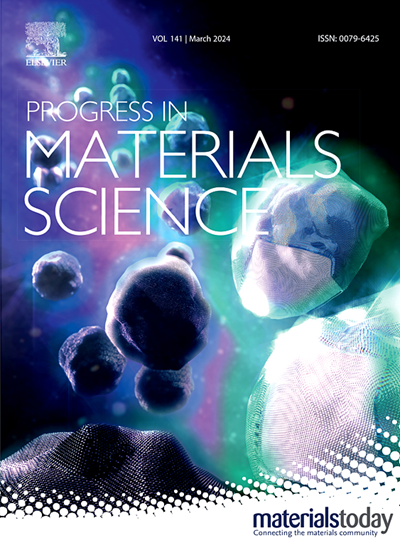等离子体超表面:光-物质相互作用、制造、应用和未来展望
IF 40
1区 材料科学
Q1 MATERIALS SCIENCE, MULTIDISCIPLINARY
引用次数: 0
摘要
等离子体超表面(PMs)由来自金属纳米结构的元原子形成的薄亚波长层组成,旨在操纵电磁场与物质之间的相互作用。纳米粒子的集体特征是由纳米粒子(NPs)的性质和底层上层结构的对称性、尺寸、顺序和方向决定的。这些综合特性使pm在传感,能量收集,纳米化,非线性光学和表面增强光谱学等应用中发挥关键作用。本文主要从光-物质相互作用、制备方法和应用三个方面进行综述。系统分析了各种等离子体超结构的近场和远场光学特性,从最简单的单个纳米结构到更复杂的一维(1D)、二维(2D)和三维(3D) PM超结构。接下来,提供了用于制造这些pm的技术的摘要,包括自顶向下、自底向上和混合策略。本文还讨论了永磁材料的各种应用,包括与二维材料、发光分子、手性分子、量子点(QDs)、上转换材料等的弱耦合和强耦合。该综述最后强调了pm当前的挑战和未来的前景,以及他们对下一代纳米光子平台的潜在进展的见解。本文章由计算机程序翻译,如有差异,请以英文原文为准。
Plasmonic metasurfaces: Light-matter interactions, fabrication, applications and future outlooks
Plasmonic metasurfaces (PMs) consist of thin, sub-wavelength layers formed by meta-atoms derived from metallic nanostructures, designed to manipulate the interaction between electromagnetic fields and matter. The collective features of PMs are determined by both the properties of the nanoparticles (NPs) and the symmetry, dimensions, order, and orientation of the underlying superstructure. These combined characteristics enable PMs to play a crucial role in applications such as sensing, energy harvesting, nanolasing, nonlinear optics and surface-enhanced spectroscopy. This review focuses on three main aspects of PMs: light-matter interactions, fabrication methods, and applications. The near-field and far-field optical properties of various plasmonic superstructures, from the simplest individual nanostructures to more complex one-dimensional (1D), two-dimensional (2D), and three-dimensional (3D) PM superstructures, are systematically analyzed. Following this, a summary of the techniques employed for the fabrication of these PMs is provided, covering top-down, bottom-up, and hybrid strategies. The diverse applications of PMs, including their weak and strong coupling with 2D materials, luminescent molecules, chiral molecules, quantum dots (QDs), upconversion materials, and more, are also discussed. The review concludes by highlighting the current challenges and future perspectives in PMs, along with insights into their potential advancements towards the next generation of nanophotonic platforms.
求助全文
通过发布文献求助,成功后即可免费获取论文全文。
去求助
来源期刊

Progress in Materials Science
工程技术-材料科学:综合
CiteScore
59.60
自引率
0.80%
发文量
101
审稿时长
11.4 months
期刊介绍:
Progress in Materials Science is a journal that publishes authoritative and critical reviews of recent advances in the science of materials. The focus of the journal is on the fundamental aspects of materials science, particularly those concerning microstructure and nanostructure and their relationship to properties. Emphasis is also placed on the thermodynamics, kinetics, mechanisms, and modeling of processes within materials, as well as the understanding of material properties in engineering and other applications.
The journal welcomes reviews from authors who are active leaders in the field of materials science and have a strong scientific track record. Materials of interest include metallic, ceramic, polymeric, biological, medical, and composite materials in all forms.
Manuscripts submitted to Progress in Materials Science are generally longer than those found in other research journals. While the focus is on invited reviews, interested authors may submit a proposal for consideration. Non-invited manuscripts are required to be preceded by the submission of a proposal. Authors publishing in Progress in Materials Science have the option to publish their research via subscription or open access. Open access publication requires the author or research funder to meet a publication fee (APC).
Abstracting and indexing services for Progress in Materials Science include Current Contents, Science Citation Index Expanded, Materials Science Citation Index, Chemical Abstracts, Engineering Index, INSPEC, and Scopus.
 求助内容:
求助内容: 应助结果提醒方式:
应助结果提醒方式:


